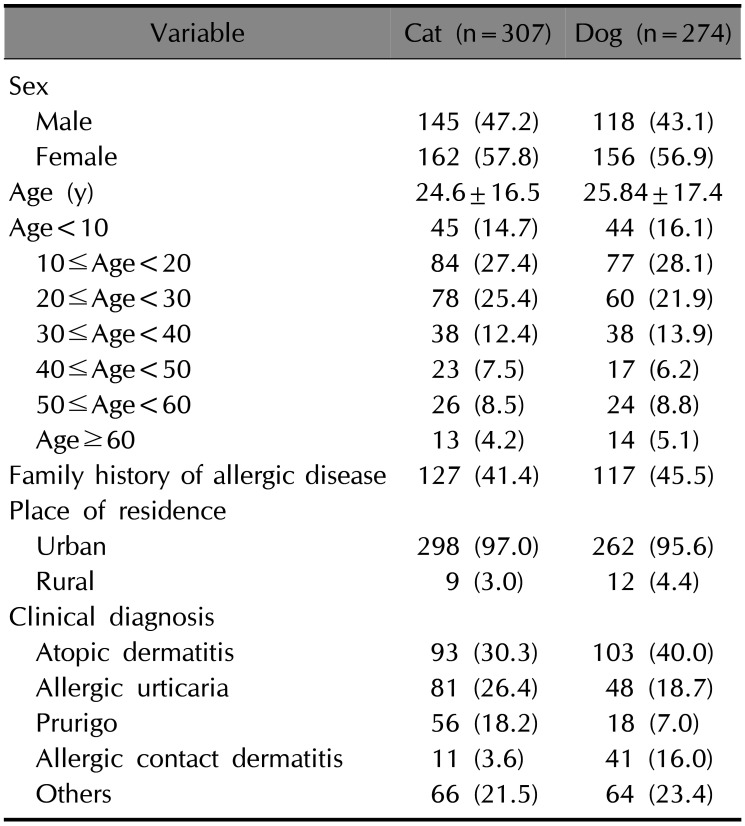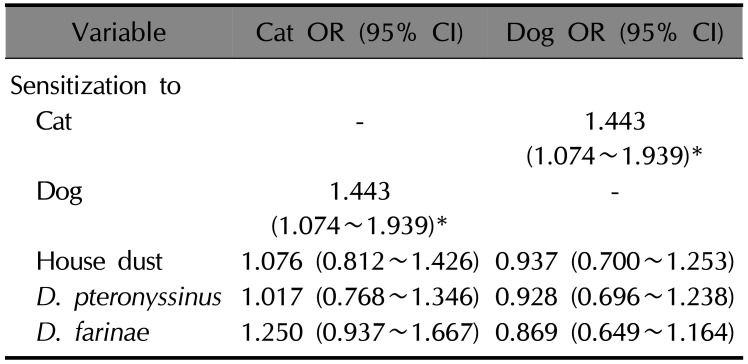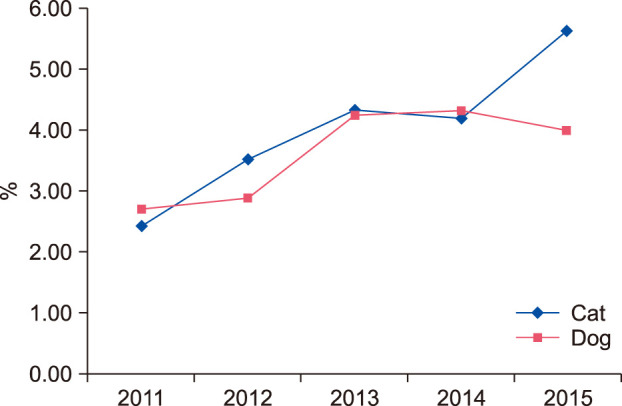1. Odhiambo JA, Williams HC, Clayton TO, Robertson CF, Asher MI. Global variations in prevalence of eczema symptoms in children from ISAAC phase three. J Allergy Clin Immunol. 2009; 124:1251–1258. PMID:
20004783.

2. Lee JH, Han KD, Kim KM, Park YG, Lee JY, Park YM. Prevalence of atopic dermatitis in Korean children based on data from the 2008-2011 Korean national health and nutrition examination survey. Allergy Asthma Immunol Res. 2016; 8:79–83. PMID:
26540505.

3. Plaschke P, Janson C, Norrman E, Björnsson E, Ellbjär S, Järvholm B. Association between atopic sensitization and asthma and bronchial hyperresponsiveness in Swedish adults: pets, and not mites, are the most important allergens. J Allergy Clin Immunol. 1999; 104:58–65. PMID:
10400840.

4. Yoo KY, Cho SH, Gin Y, Lee YJ. Strategic guidelines to protect and manage pet animals in Seoul (SDI 04-R-21). Seoul: The Seoul Institute;2004.
5. Korean gallup. Pet ownership status and awareness survey in Korea. Seoul: Korea Pet Food Association;2017. p. 58.
6. Calabria CW, Dietrich J, Hagan L. Comparison of serum-specific IgE (ImmunoCAP) and skin-prick test results for 53 inhalant allergens in patients with chronic rhinitis. Allergy Asthma Proc. 2009; 30:386–396. PMID:
19772760.

7. Jung YG, Cho HJ, Park GY, Min JY, Kim HY, Dhong HJ, et al. Comparison of the skin-prick test and Phadia Immuno-CAP as tools to diagnose house-dust mite allergy. Am J Rhinol Allergy. 2010; 24:226–229. PMID:
20537291.

8. Koh HS, Lee KS, Han DH, Rah YH, Choi SH. Relationship between serum total IgE, specific IgE, and peripheral blood eosinophil count according to specific allergic diseases. Allergy Asthma Respir Dis. 2013; 1:123–128.

9. Yilmaz I, Oner Erkekol F, Secil D, Misirligil Z, Mungan D. Cat and dog sensitization in pet shop workers. Occup Med (Lond). 2013; 63:563–567. PMID:
24174631.

10. Custovic A, Hallam CL, Simpson BM, Craven M, Simpson A, Woodcock A. Decreased prevalence of sensitization to cats with high exposure to cat allergen. J Allergy Clin Immunol. 2001; 108:537–539. PMID:
11590378.

11. Custovic A, Simpson BM, Simpson A, Hallam CL, Marolia H, Walsh D, et al. Current mite, cat, and dog allergen exposure, pet ownership, and sensitization to inhalant allergens in adults. J Allergy Clin Immunol. 2003; 111:402–407. PMID:
12589363.

12. Enberg RN, Shamie SM, McCullough J, Ownby DR. Ubiquitous presence of cat allergen in cat-free buildings: probable dispersal from human clothing. Ann Allergy. 1993; 70:471–474. PMID:
8507041.
13. D'Amato G, Liccardi G, Russo M, Barber D, D'Amato M, Carreira J. Clothing is a carrier of cat allergens. J Allergy Clin Immunol. 1997; 99:577–578. PMID:
9111506.
14. Patchett K, Lewis S, Crane J, Fitzharris P. Cat allergen (Fel d1) levels on school children's clothing and in primary school classrooms in Wellington, New Zealand. J Allergy Clin Immunol. 1997; 100:755–759. PMID:
9438482.
15. Almqvist C, Larsson PH, Egmar AC, Hedrén M, Malmberg P, Wickman M. School as a risk environment for children allergic to cats and a site for transfer of cat allergen to homes. J Allergy Clin Immunol. 1999; 103:1012–1017. PMID:
10359879.

16. Custovic A, Simpson A, Chapman MD, Woodcock A. Allergen avoidance in the treatment of asthma and atopic disorders. Thorax. 1998; 53:63–72. PMID:
9577525.

17. Partti-Pellinen K, Marttila O, Mäkinen-Kiljunen S, Haahtela T. Occurrence of dog, cat, and mite allergens in public transport vehicles. Allergy. 2000; 55:65–68. PMID:
10696858.

18. Chan-Yeung M, McClean PA, Sandell PR, Slutsky AS, Zamel N. Sensitization to cat without direct exposure to cats. Clin Exp Allergy. 1999; 29:762–765. PMID:
10336591.

19. Kim TB, Kim KM, Kim SH, Kang HR, Chang YS, Kim CW, et al. Sensitization rates for inhalant allergens in Korea; a multi-center study. J Asthma Allergy Clin Immunol. 2003; 23:483–493.
20. Svanes C, Zock JP, Antó J, Dharmage S, Norbäck D, Wjst M, et al. Do asthma and allergy influence subsequent pet keeping? An analysis of childhood and adulthood. J Allergy Clin Immunol. 2006; 118:691–698. PMID:
16950289.

21. Kim J, Hahm MI, Lee SY, Kim WK, Chae Y, Park YM, et al. Sensitization to aeroallergens in Korean children: a population-based study in 2010. J Korean Med Sci. 2011; 26:1165–1172. PMID:
21935271.

22. Lee SE, Kim JY, Kim YA, Cho SH, Ahn HJ, Woo HM, et al. Prevalence of Toxoplasma gondii infection in stray and household cats in regions of Seoul, Korea. Korean J Parasitol. 2010; 48:267–270. PMID:
20877509.
23. Spitzauer S, Pandjaitan B, Mühl S, Ebner C, Kraft D, Valenta R, et al. Major cat and dog allergens share IgE epitopes. J Allergy Clin Immunol. 1997; 99:100–106. PMID:
9003217.

24. Madhurantakam C, Nilsson OB, Uchtenhagen H, Konradsen J, Saarne T, Högbom E, et al. Crystal structure of the dog lipocalin allergen can f 2: implications for cross-reactivity to the cat allergen Fel d 4. J Mol Biol. 2010; 401:68–83. PMID:
20621650.

25. Linneberg A, Nielsen NH, Madsen F, Frølund L, Dirksen A, Jørgensen T. Pets in the home and the development of pet allergy in adulthood. The Copenhagen allergy study. Allergy. 2003; 58:21–26. PMID:
12580802.

26. Erwin EA, Rönmark E, Wickens K, Perzanowski MS, Barry D, Lundbäck B, et al. Contribution of dust mite and cat specific IgE to total IgE: relevance to asthma prevalence. J Allergy Clin Immunol. 2007; 119:359–365. PMID:
17291853.







 PDF
PDF ePub
ePub Citation
Citation Print
Print





 XML Download
XML Download